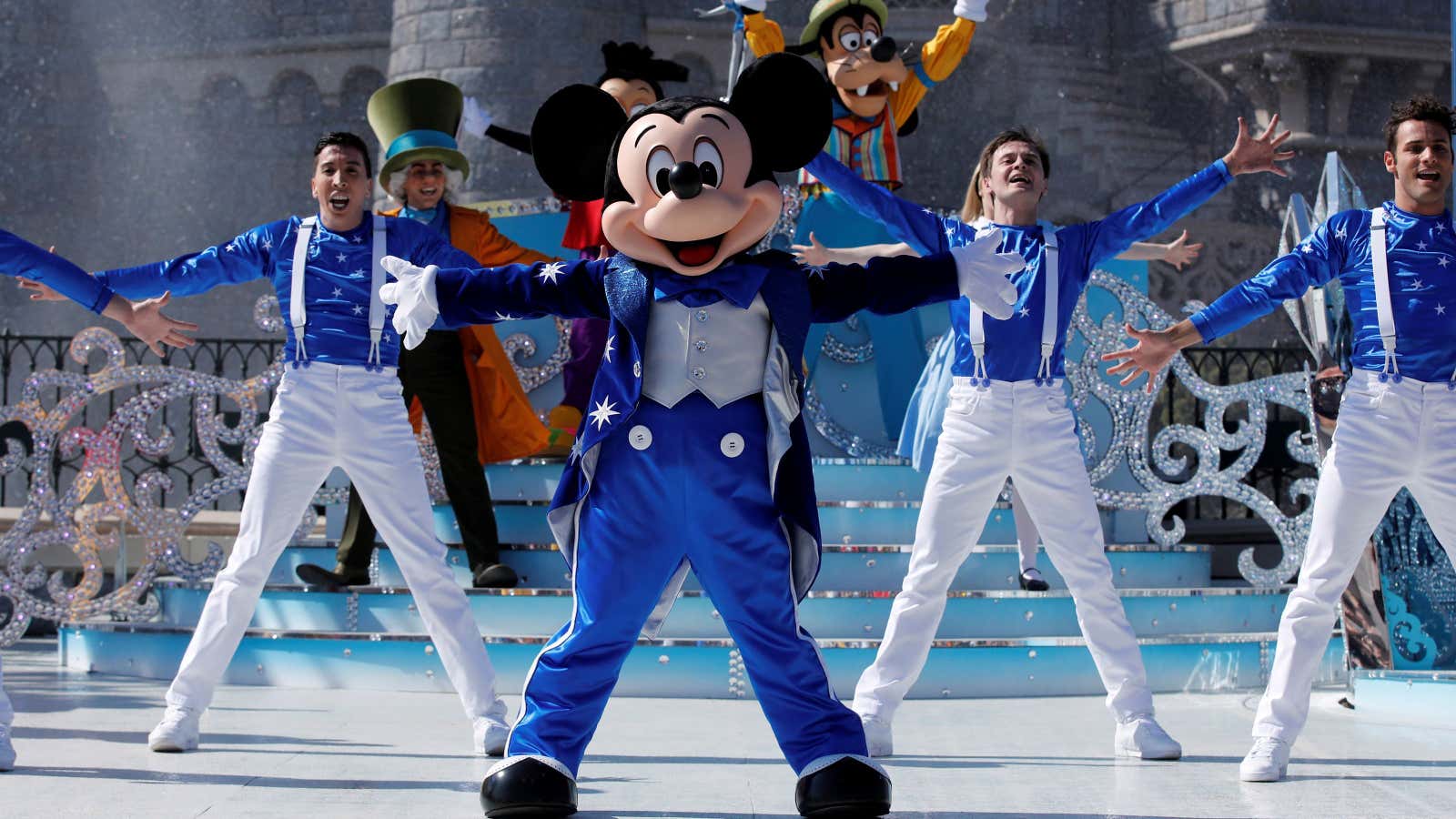Manchester United manager Jose Mourinho recently criticised his players for not having the courage to take penalty kicks, declaring: “I don’t like Mickey Mouses.” His choice of words made him surely just the latest to misunderstand one of the most significant icons of our times.
The term “Mickey Mouse” is often used as a term of dismissal—for watches, academic courses dealing with the media and popular culture, and other apparently “non-serious” practices. But its continued use actually displays Mickey’s longstanding social influence.
Celebrating his 90th birthday this year, the Disney cartoon character has far outgrown his role as erstwhile straight man to funnier companions such as Goofy, Pluto, and Donald Duck. His everyman persona is now linked to a range of complex values in global culture.
Nine decades ago, surely nobody would have imagined when Walt Disney invented Mickey (he was initially named Mortimer Mouse), the mischievous rustic mouse of early black-and-white cartoons such as Steamboat Willie and Plane Crazy, that he would become such a powerful brand.
Easily identified by nothing more than a white glove or those famous ears, he has come to represent the core principles of what it is to be American. He epitomizes the ultimate triumph of late industrial capitalism and corporate identity.
Disney’s critical currency was almost untouchable in the 1930s and 1940s, as Mickey was embraced by both the general public and the intellectual cognoscenti. After Walt died in 1966, the “death of the author” only strengthened the long reach of his symbolic son.
Mickey the wide eyed rodent was never really seen as a mouse. The scientist Stephen Jay Gould suggested he provoked empathy in audiences simply because of his resemblance to a baby or young child. But it was Mickey’s starring role in Fantasia in 1940, as The Sorcerer’s Apprentice, which moved him beyond associations with the Great Depression, and into more progressive times.
Gone was the barnyard imp, replaced by a curious, energized figure literally containing the powerful forces of the universe. After that it was but a small step to world domination. But it was a domination which provoked a mixed response.
Cultural critic Henry Giroux worried about an end to innocence in the manipulation of the Disney ethos embodied in Mickey. Film writer Douglas Brode later argued that Disney was far more radical than we think, and actually a defining player in 20th-century consciousness.
Disney champion and filmmaker Sergei Eisenstein saw Mickey’s cartoon form as a liberating force for change, loosening the straitjacket of modern American culture while ironically being one of its defining forms. (Yet Eisenstein took little note of Mickey’s already dominant presence in merchandising. As historian Gary Cross points out, by the 1930s, Mickey’s figure was already being imprinted on “blankets, watches, toothbrushes, lampshades, radios, breakfast bowls, alarm clocks, Christmas tree lights, ties, and clothing of all kinds”.)
Of mice and men
The discussion—and Mickey’s cultural dominance—has been widespread. The book How to Read Donald Duck, for example, offers a Marxist perspective on Disney comics, where Mickey is on the front line of American cultural imperialism.
In the art world, Andy Warhol created the Mickey Mouse Myths series in the early 1980s, street artist Keith Haring made images of Warhol as the famous rodent. Satirical cartoonist Robert Grossman fused Mickey with Ronald Reagan and designer Rick Griffin drew him as a protest singer—a sort of Disneyfied Dylan.
Digital artist John Craig “proved” Mickey’s existence through geometry, and graphic designer Seymour Chwast summed up the simplicity of his construction in How to Draw Seven Circles.
At 90 years of age, Mickey—those seven circles—now stands astride popular culture and politics, embodying all its contradictions and ambiguities, pleasures and pains, past and present. He can be hugged in theme parks, enjoyed on screens, and admired for his sheer longevity.
And while Mickey may represent multiple meanings, notions of nostalgia and utopia remain embodied in his simple form. At one time this might have seemed backward looking and naive—but it has now made him a reassuring presence, as the world seems to slide unerringly into chaos and decline.
Little wonder then, that Mickey’s whistle from Steamboat Willie in 1928 is now used as a prologue to Disney Pixar Films. As Walt always reminded everyone: “It started with a mouse.” And as yet, much to the relief of those who embrace the House of Mouse (and there are many), there is no ending in sight.
This article is republished from The Conversation under a Creative Commons license. Read the original article.
